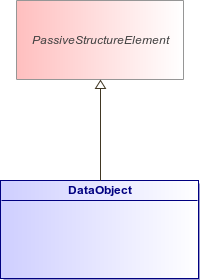
ArchiMate Metamodel
A data object represents an encapsulation of information that is recognized by a business expert as a thing and is suitable for automated processing.
A data object should be a self-contained piece of information with a clear meaning to the business, not just to the application level. Typical examples of data objects are a customer record, a client database, or an insurance claim.
The ArchiMate language in general focuses on the modeling of types, not instances, since this is the most relevant at the Enterprise Architecture level of description. Hence a data object typically models an object type (cf. a UML class) of which multiple instances may exist in operational applications. An important exception is when a data object is used to model a data collection such as a database, of which only one instance exists.
An application function or process can operate on data objects.
A data object may be communicated via interactions and used or produced by application services.
A data object can be accessed by an application function, application interaction, or application service.
A data object may realize a business object, and may be realized by an artifact.
A data object may have association, specialization, aggregation, or composition relationships with other data objects.
The name of a data object should preferably be a noun.
